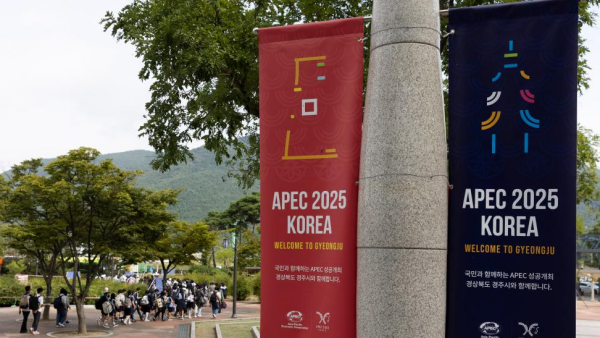


Integration a strategic imperative for Asia-Pacific prosperity

Posters of the Asia-Pacific Economic Cooperation (APEC) meeting in Gyeongju, South Korea. /Xinhua
The 2025 APEC Economic Leaders' Meeting, themed "Building a Sustainable Future: Connectivity, Innovation, and Prosperity," is being held in Gyeongju, South Korea this week.
This year's agenda addresses critical junctures in global industrial restructuring and geopolitical competition. Amid rising protectionism and geopolitical fragmentation, and as advancing regional integration transcends economic considerations – it has become a strategic choice vital for regional prosperity and ensuring resilient growth across all 21 participating economies.
Currently, the Asia-Pacific region, recognized as the world's primary growth engine, contributes over 60 percent of the world's economy and nearly half of international trade. However, growing imbalances in regional development have emerged.
On the one hand, the widening technological divide between developed economies and emerging markets hinders small and medium-sized enterprises from integrating into global value chains due to high cross-border costs. On the other, security concerns over supply chains have fueled a trend of "nearshore outsourcing," thus undermining the synergies of traditional division of labor.
More critically, the spread of trade unilateralism risks fracturing existing regulatory frameworks and exacerbating market uncertainties. In this context, deepening regional integration has become crucial for maintaining Asia-Pacific competitiveness. This approach not only reduces transaction costs through economies of scale but also enhances overall efficiency through unified standards, while serving as a buffer against external risks.
The core goal of Asia-Pacific regional integration is to achieve connectivity, trade facilitation and institutional coordination. How can we better achieve these goals to promote the free flow of factors of production such as people, capital and information and further unleash the overall development potential of the region?
Hardware connectivity is the foundation of regional economic integration. Currently, economies in the Asia-Pacific should focus on expanding and optimizing infrastructure such as transportation, energy, and communications, promoting coordinated construction of cross-border railways, highways, ports, and digital networks, and building efficient and smooth logistics and supply chain systems to provide solid support for the flow of goods and capital within the region.
For example, China has provided important support for extending regional trade routes through cooperation with countries like Indonesia, Malaysia, and Vietnam on port and railway projects under the Belt and Road Initiative.
The "soft alignment" of institutional rules remains equally vital. Priority should be given to implementing the WTO Trade Facilitation Agreement, streamlining customs clearance procedures, and advancing modernization reforms in customs and border management departments. For instance, by promoting the "Single Window" system to achieve paperless trade and digitize critical processes, economies can reduce time and costs in cross-border trade. This helps to compress goods clearance time from days to hours.
Simultaneously, enhancing policy coordination and establishing information-sharing platforms will enable timely dissemination of trade policies and market trends, improving transparency and predictability to foster a more open and equitable business environment.
The intensity of people's interactions determines the depth of cooperation. Economies should ease visa policies, extend stay durations, establish talent innovation and entrepreneurship pilot zones, promote mutual recognition of professional certifications, and streamline cross-border practices.
This will facilitate the cross-border mobility of entrepreneurs, scholars, artisans, and tourists. When cultural inspiration sparks innovative ideas through such exchanges, people-to-people interactions naturally become the lubricant for economic and trade collaboration.
Acceleration of cooperation in digital and artificial intelligence is equally important. The digital economy has emerged as a new growth engine for the Asia-Pacific region. Asia-Pacific economies should strengthen collaboration in fields such as artificial intelligence, big data, and cloud computing, encourage cross-border data flows, establish unified data security standards, and better achieve efficient information sharing and innovative applications.
To enhance connectivity, adherence to the original aspiration of true multilateralism matters. Against the backdrop of rising geopolitical tensions and trade protectionism, Asia-Pacific economies should firmly uphold the rules-based multilateral trading system, strengthen dialogue and consultation, and fully implement free trade agreements such as RCEP, combining trade and investment liberalization with sustainable development to achieve common prosperity.
As an important member of APEC, China has contributed 64.2 percent to Asia's economic growth, driving 37.6 percent growth in regional goods trades and 44.6 percent growth in service trades. This contribution stems not only from the continuous expansion of China's economic scale but also from the ongoing multilateral cooperation under the APEC framework.
Looking back at this pivotal historical juncture, the Asia-Pacific's development has never been a zero-sum game, but rather a stage of multiplier effects. When infrastructure weaves a web of connectivity, institutional innovations break down barriers, digital waves level information disparities, and talents unleash their wisdom, and this vast region will inevitably surge with renewed momentum.
Imagine, if artisans in the most remote villages can secure orders through e-commerce platforms to transform their and their families' destinies, and clean energy technologies in members' laboratories can cross borders without obstacles to ultimately light up countless homes, perhaps these envisioned scenarios are the most vivid embodiment of a "sustainable future."
Qian Feng is a senior research fellow at the National Strategic Institute, Tsinghua University.
Editor:Yu Hui
Copyright©2023 CSSN All Rights Reserved